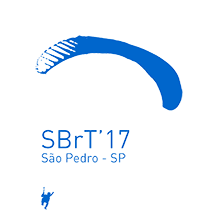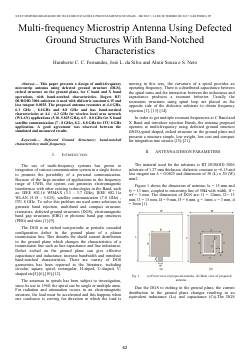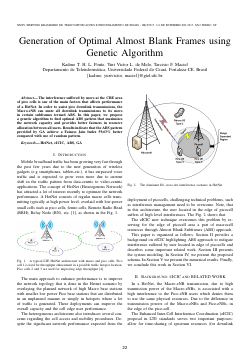
XXXV Simpósio Brasileiro de Telecomunicações e Processamento de Sinais

Multi-frequency Microstrip Antenna Using Defected Ground Structures With Band-Notched Characteristics
Humberto C. C. Fernandes, José L. da Silva, Almir Souza, S. Neto
DOI: 10.14209/sbrt.2017.83
Keywords: Defected Ground Structures band-notched characteristics multi-frequency
Abstract
This paper presents a design of multi-frequency microstrip antenna using defected ground structure (DGS), etched structure on the ground plane, for C band and X band operations, with band-notched characteristics. Rogers RT/ DUROID 3006 substrate is used with dielectric constant 6.15 and loss tangent 0.0025. The proposed antenna resonates at 4.4 GHz, 6.3 GHz , 8.1GHz and 8.8 GHz and has band-notched characteristics at 4.4 - 6.2 GHz for wireless local area network (WLAN) applications (5.18–5.825 GHz), 6.5 - 8.0 GHz for X band satellite communication (7 - 8 GHz), 8.2 - 8.8 GHz for ITU 8 GHz application. A good agreement was observed between the simulated and measured results.Download

Estratégias de Transmissão para uma Rede com Canal Retransmissor Multidirecional
Marcio Henrique Doniak, Richard Demo Souza, Bartolomeu F. Uchôa-Filho
DOI: 10.14209/sbrt.2017.23
Keywords: Multiway relay channel Effective Rate VANET
Abstract
A multiway relay channel (mRC) which is widely employed in the literature is extended to represent a larger num- ber of practical scenarios, such as a vehicular network (VANET). For the proposed system, g-mRC, three transmission strategies are presented and analyzed in terms of maximum effective rate, for different numbers of users. Numerical results show that the best strategy is the one in which all users transmit simultaneously in the multiple access phase. Each strategy presents an optimal number of users which maximizes the effective rate. The system model and the transmission strategies presented can be useful in several practical scenarios.Download

Localizando ponto de impacto de projétil Alto Explosivo (AE), empregando arranjo de microfones
Felipe Gonçalves Serrenho, Juliano Garcia do Carmo Ribeiro, José A. Apolinário Jr
DOI: 10.14209/sbrt.2017.38
Keywords: Direction of arrival microphone array target localization
Abstract
This work presents a way to determine the im- pact position of a high-explosive projectile using microphone arrays. Three distinct arrays are placed in equally spaced and fixed positions. After signals acquisition, the Generalized Cross- Correlation Algorithm is applied to obtain the cross-correlation peak in order to estimate the time-difference of arrival of the signal to each pair of microphones in the array. According to the microphones relative positions and the estimated delays, the directions of arrival are obtained. Based on these estimates, the least squares method is used to determine the most probable coordinates of the impact position.Download

Transfer Entropy Characterization of TBI Cases
Milena M. Arruda, Luciana R. Veloso, Francisco M. de Assis
DOI: 10.14209/sbrt.2017.24
Keywords: Arterial blood pressure transfer entropy traumatic brain injury electrocardiogram
Abstract
Traumatic brain injury (TBI) is an important public health problem worldwide. This paper introduces transfer entropy as a measure to identify any standard between arterial blood pressure and electrocardiogram signal for patients diagnosed with TBI. Therefore, we will review the basic definitions of information theory and transfer entropy, which interpretation is influenced not only by the Kullback-Leibler divergence, but also by conditioned mutual information. For transfer entropy measurement we used Kraskov-Stögbauer- Grassberger (KSG) technique. It is observed that directionality in transfer entropy can provide clinical decision support for TBI cases.Download

O Impacto do Ataque Hello no Protocolo de Roteamento RPL
Estefania Pianoski, Jeferson Cotrim, João Henrique Kleinschmidt
DOI: 10.14209/sbrt.2017.102
Keywords: Internet das Coisas RPL Ataque Hello Segurança da Informação.
Abstract
A Internet das Coisas (IoT) tem atraído a atenção nos últimos anos, tanto da área acadêmica quanto do mundo dos negócios. Por em para o funcionamento da IoT foi necessário o desenvolvimento de novos protocolos, dentre eles o protocolo de roteamento RPL. Este protocolo atende as demandas das redes de baixa potencia e com perdas, sendo também, até o momento o único protocolo de roteamento padronizado para IoT. Apesar da grande aceitação do RPL, este ainda apresenta algumas deficiências que precisam ser sanadas, dentre elas diversas questões associadas a segurança da informação. O objetivo deste trabalho e avaliar o impacto de um ataque Hello no desempenho do RPL. Os testes foram realizados com o Contiki/Cooja e as metricas avaliadas foram o consumo de energia dos nos, a taxa de entrega e atraso de pacotes de dados. Com os resultados obtidos foi possível identificar que o ataque Hello no RPL pode gerar uma negação de serviço, seja pelo esgotamento da energia dos nos da rede ou pela diminuição da entrega de pacotes.Download

Redução de profundidade de lógica de hardware para codificação de LDPC
Alexandre Felipe, André L.N. Souza
DOI: 10.14209/sbrt.2017.36
Keywords: Low-density parity-check codes LDPC Latency Encoding
Abstract
Low-density Parity-check codes constructed for co- ding with linear computational complexity normally generate encoder hardware with high logical depth. This work indicates strategies to manipulate a triangular equation system in order to reduce the non-parallelizable stages, and consequently lower enconding latency, allowing faster bit rates.Download

Máquinas de Aprendizado Extremo para Classificação Online de Eventos no detector ATLAS
Marton S. dos Santos, Edmar E. P. de Souza, Eduardo F. Simas Filho, Paulo C. M. A. Farias, Werner S. Freund, José M. de Seixas
DOI: 10.14209/sbrt.2017.103
Keywords: ELM Neural Network Signal Processing ATLAS detector
Abstract
ATLAS is one of the LHC (Large Hadron Collider) detectors, and is located at the European Organization for Nuclear Research (CERN). For proper characterization of the particles an accurate measurement of the energy deposition profile is required as interactions with the detector occur. In ATLAS, the calorimeters are responsible for estimating the energy of the particles and, in this sense, they use more than 100,000 sensors. One of the discriminators for the online detection of electrons used in ATLAS is the Neural Ringer, in which the energy deposition profile is used as input to a multi-layer perceptron neural classifier. This work proposes the use of Extreme Learning Machines (ELM) in substitution of perceptron neural networks in Neural Ringer. The results obtained from a simulated database point to a significant reduction in training time, maintaining similar classification performance.Download

Classificação de Vagas de Estacionamento usando Aprendizagem de Máquina
Gabriel Rosa e Silva, Walter Antonio Gontijo
DOI: 10.14209/sbrt.2017.39
Keywords: Machine learning SVM RBF embedded systems
Abstract
In this paper we present contributions to the classification of parking spaces monitored by video cameras, using machine learning with classification by Support Vector Machine. The contributions include the usage of a Radial Basis Function kernel and of a threshold in the decision region. Such contributions lead to better classification accuracy with little impact in the performance of an embedded implementation. The proposed method is implemented in an embedded environment, classifying up to 256 parking spaces per image with the expected accuracy.Download

Generation of Optimal Almost Blank Frames using Genetic Algorithm
Kadmo T. H. L. Ponte, Yuri Victor L. de Melo, Tarcisio F. Maciel
DOI: 10.14209/sbrt.2017.104
Keywords: HetNet eICIC ABS GA
Abstract
The interference suffered by users at the CRE area of pico cells is one of the main factors that affects performance of a HetNet. In order to assist pico downlink transmissions, the Macro-eNB can mute all downlink transmissions to its users in certain subframes termed ABS. In this paper, we propose a genetic algorithm to find optimal ABS pattern that maximizes the network capacity and provides better fairness in resource allocation between all users. Results indicate that the ABS pattern provided by GA achieve a Fainess Jain Index 59,63% better compared with use of random pattern.Download

A New Approach for Electrooculogram Recognition Algorithms
Andrei Borges La Rosa, Virgı́nia Bordignon, Carla Diniz Lopes Becker, Sergio Jose Melo de Almeida
DOI: 10.14209/sbrt.2017.40
Keywords: Eletrooculogram Human machine interface Pat- tern recognition Discrete Wavelet Transform
Abstract
In this work we analyze electrooculogram (EOG) signals’ properties, and propose two recognition algorithms for translating signal patterns into actual eye movements. The ob- jective is to provide a reliable and low cost classification method for Human Machine Interface (HMI) applications. An EOG signal database is generated through an acquisition system. This database is later used to validate the proposed pattern recognition methods, in which the discrete wavelet transform (DWT) was applied to represent the signal with less coefficients. Finally, the results are presented and compared with other extraction methods to distinguish patient’s intents through EOG.Download